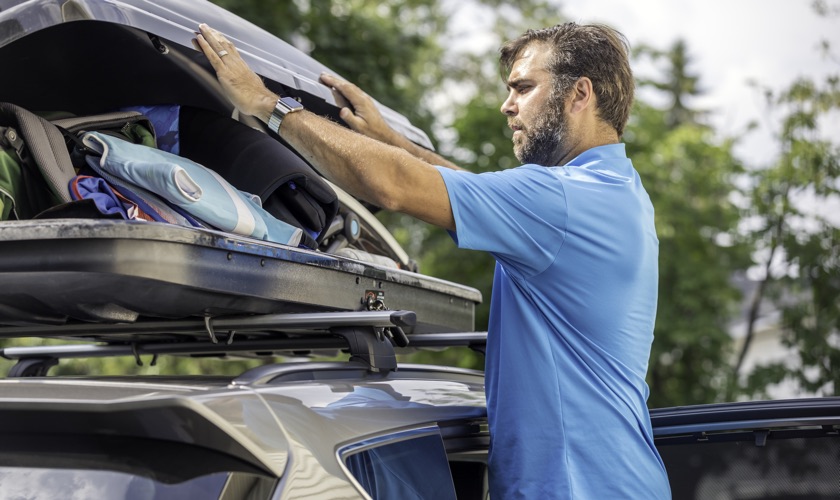Prep your car for driving with heavy loads

Travelling by road presents a challenge even for the lightest of packers — especially if you have children.
To ensure you can pack everything you need while making sure the car can handle the extra weight, there are three main techniques you can use: the car boot, roof racks and trailers.
In this article, we’ll explore how you can prep your car for heavy loads, covering three main techniques.
How do heavy loads affect a car?
Carrying extra weight can take its toll on vehicles and affect the handling of your car. For example, tyre wear and tear increases, steering may not be as precise and fuel consumption will also increase.
To help your vehicle and tyres stay as performant as possible when transporting more weight, check out our tips below.
How to prep your car for heavy loads
Roof racks / roof boxes
Driving with a roof rack or box needs a bit of prep, so here’s how to approach it safely:
- First, make sure you are familiar with roof box and roof rack restrictions. Loaded items on the roof cannot obscure the driver’s view at all and there are limits to how much items can overhang the front (15cm), rear (50cm) or sides (50cm) of the vehicle.
- Next, establish whether you will place luggage and/or equipment directly to the roof rack beams or if you will invest in a more secure roof box. Also, make sure you have the right attachment depending on what you are transporting as surfboards, canoes, bikes etc, may require specialist fittings to limit unwanted side effects resulting from air resistance.
- Identify your static roof load (maximum weight your roof can support when stationary) and your dynamic roof load (maximum weight your roof can support when moving) as movement puts additional stress on the roof. To discover these figures, check your manufacturer handbook or the VIN plate under the bonnet. Don’t forget the racks/bars will count towards these limits too.
- Increase your tyre pressure to withstand the extra weight, as heavy loads affect tyre wear and tear, along with handling of a vehicle. Typically drivers apply the ‘laden weight’ tyre pressures indicated in your handbook or door sill. When taking the rack/box off, you should reduce the tyre pressure again too.
- When packing a roof rack box, make sure everything is secure rather than rattling around inside. You may choose to use elasticated ropes (aka bungee cords) to keep things in place or stuff things in place with blankets or towels.
- Be aware of the new height of your vehicle with the luggage as this may affect your ability to enter or drive through certain areas.
- Additionally, the sun roof must not be used (i.e. open) when a roof box is attached as the air pressure when moving can break the glass.
Trailers
Trailers are a tried and tested way of giving your vehicle a whole lot more storage. That said, there’s a few things you need to be aware of.
- Under new laws, the weight you are allowed to tow is different depending on when you obtained your driving licence, so check carefully using Government resources.
- By law, your trailer must display the same number plates as the vehicle doing the towing. Likewise, it’s a legal requirement for trailers to be fitted with the appropriate lights, such as indicators and fog lights. Before setting off, check these are working.
- Make sure that everything is secure, especially when you consider that you may be travelling at high speeds, so consider that everything must be firmly affixed enough to withstand the force of wind resistance. You might choose to add a tarp to cover the items within.
- Driving a car with a trailer requires a slightly different style of driving. For those brand new to it, you may wish to practise on quiet side streets at low speed to get a feel for it. There are also instructors that can help get you ready so you can drive with confidence.
- There are speed limits specific to vehicles that are towing trailers: 30 mph in built-up zones, 50 mph on single carriageways, and 60 mph on motorways or dual carriageways. The reduced speed limits are due to the fact that trailers take longer to slow down because of their extra weight.
Car Boot
The car’s boot is the most traditional way of transporting extra goods, but even they can have an art to utilising them.
- Take everything unessential out of the boot first to create more space. If you’re feeling motivated, this might be time to give the boot a likely long-forgotten clean.
- Bulkier items should go on the bottom, and smaller, squisher items should be fitted around these larger items.
- Be mindful of visibility whilst driving/reversing – you could obscure your rear view mirror by stacking the boot too high.
- If you’re taking no passengers in the back seat, then many cars can lay these flat to extend the capacity of your boot space.
- Depending on how much you wish to load up the car, consider increasing tyre pressure to withstand this extra weight. Refer to your car handbook or door sill for the specific amount to increase to.
- Bonus tip: if you haven’t discovered vacuum-packing, now could be the time to try. This handy technique is super-useful for storing and transporting clothes, leaving more room for other objects.
Get your car road-ready for any journey with help from Mr Tyre. With over 50 years as a leading chain of autocentres for Central England, you can count on us to provide an array of car parts, servicing and, of course, tyres for any make of vehicle. Contact your local branch today.

